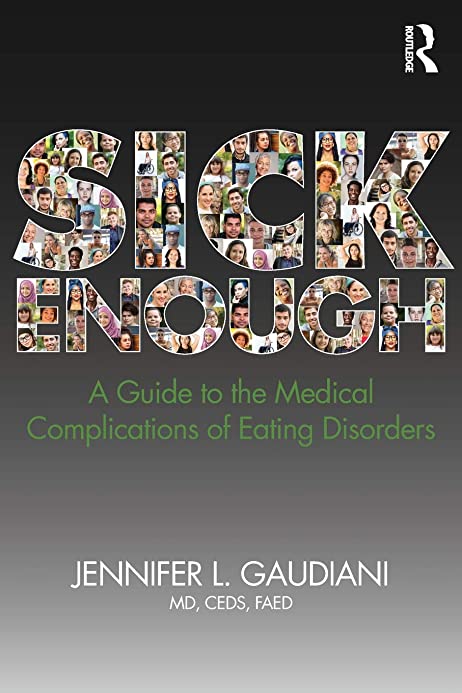
Sick Enough. A Guide to the Medical Complications of Eating Disorders.
By Jennifer L. Gaudiani, MD, CEDS, FAED. New York, NY: Routledge, 276 pp, paperback, $38.34.
In her superb new book, Sick Enough, Dr. Jennifer Gaudiani deftly combines the personal, political, and practical aspects of the medical treatment of eating disorders. She begins by telling us about her background. The oldest of three sisters, she was in medical school when her middle sister developed bulimia nervosa. Her sister suffered for many years (she has now recovered) and Dr. Gaudiani felt “scared and powerless” when her sister was in her illness. Her sister’s courage during her recovery journey, said Dr. Gaudiani, “inspired me to get into this field and take back power so that others might be helped.” Dr. Gaudiani has since become one of the world’s leading specialists in this disorder and reminds us that “illness in a family can bring surprising gifts and awaken opportunities to see the world in a new way.” She encourages family members to advocate for their loved one with the knowledge in this book because so many medical providers “simply haven’t had sufficient experience with eating disorders.”
The book is divided into five major sections. The first section goes into all of the medical consequences of starvation caused by AN, avoidant/restrictive food intake disorder (ARFID), or other eating disorders. Dr. Gaudiani does a great job in making complex medical concepts understandable. For example, at the beginning of the chapter on starvation, we are introduced to the concept of the “cave person brain.” This is the part of our brain that responds to starvation – food shortages would have been common for our hunter-gatherer ancestors. The genes that best conserved energy during these periods have survived over time. One successful set of genes lowers sex hormones in times of famine (trying to make babies can be a losing strategy during times of insufficient energy). Another set pushes us to become more anxious and vigilant (making us more likely to find dinner and less likely to become another predator’s dinner). A third winning set lowers metabolism to save energy in ways similar to those of our mammalian relatives. Consider the bear: “All winter, while bears mostly sleep, their metabolic rate falls 75 percent. Their heart rate drops to 10-20 beats a minute, and they breathe once every 45 seconds.” Dr. Gaudiani reminds her patients that “…humans are not bears and shouldn’t ever go into metabolic hibernation. Also, when bears hibernate, they sleep all winter. They don’t, while fasting, work a full-time job, get a 4.0, raise children, connect with friends, keep up on social media or go to the gym. They sleep.”
The next section describes the different types of purging and the medical consequences that they cause. Medical signs, symptoms, diagnostic tests, and treatments are discussed for vomiting and laxative and diuretic abuse. As in other sections of the book, there are illuminating case studies that show tremendous respect for the humans involved in these struggles─people are never reduced to just a collection of organ systems.
The third section, “Patients in Larger Bodies,” focuses on patients with BED in larger bodies as well as discussing implications for any individual in a larger body. Dr. Gaudiani brings much-needed attention to social justice issues as well as the negative consequences of size stigma. Patients, families, and many in the medical professions will benefit from this necessary correction to long-standing prejudicial attitudes and practices.
The fourth section, “The Unmeasurables,” deals with serious medical problems that can co-occur with eating disorders but are difficult to definitively diagnose. Separate chapters deal with irritable bowel syndrome (IBS) and postural orthostatic tachycardia syndrome (POTS).
The last section discusses numerous specific populations, such as patients with diabetes mellitus, orthorexia, and ARFID. There are also chapters covering elite athletes, male patients, gender and sexual minorities, and women’s sexual and reproductive health, as well as chapters covering older patients and those with co-morbid substance abuse.
Dr. Gaudiani weaves the concept of ‘values’ throughout the book: “I invite each of my patients to share with me what really matters to them, what elements of their lives are most important, and what traits make them fundamentally themselves.” This search for values shares much with the development of ethics in classical philosophy – a study of how to live one’s life. The classical virtues, such as the need for courage, practical wisdom and justice are much in evidence in this book. The final chapter: “Caring for the Patient Who Declines Treatment” shows the use of another classical virtue – the need for temperance or moderation. In discussing certain patients with severe and enduring AN, Dr. Gaudiani says: “These are people whose suffering is so immense due to their eating disorder and psychiatric comorbidities, without relief from standard and even experimental treatments, that it is clearly inhumane to require them to suffer further… They deserve to have a voice in electing less aggressive care should they desire.” What makes this book so compelling and helpful is Dr. Gaudiani’s combination of deep medical knowledge and a fundamental respect for each person’s individuality and values.
– Russell Marx, MD

